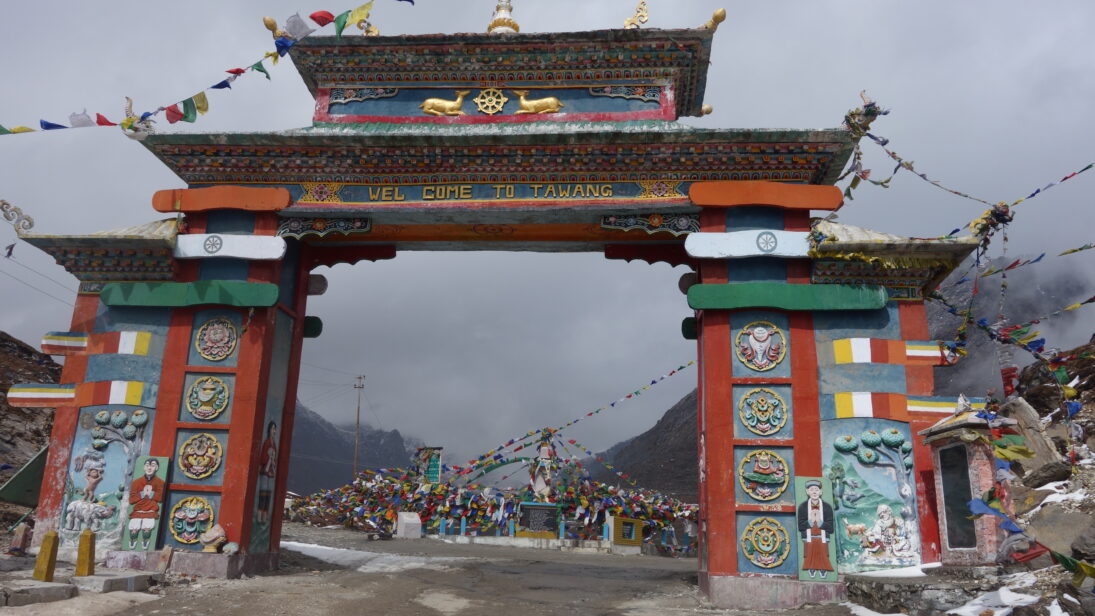
Arunachal Pradesh is swiftly emerging as a point of heated discord between India and China. On December 29, 2021, China upped the ante and announced its decision to “standardize” the names of 15 places in Arunachal—which Chinese maps depict as “Zangnan,” or South Tibet. The newly named locations cover 11 of the state’s 25 districts and stretch from Tawang in the west to Anjaw in the east. India was quick to respond to the name changes with the Ministry of External Affairs spokesperson Arindam Bagchi calling the “invented” names for Indian territories a “ridiculous exercise.” However, the name changes coupled with China’s new Land Border Law, passed on October 23, 2021 and effective on January 1, undoubtedly raised some level of alarm in New Delhi.
While much of the focus has been on the western sector with the unresolved conflict in Ladakh since May 2020, such moves point to the eastern sector becoming increasingly pivotal in deciding the future of India-China ties. As both countries observe the 60th anniversary of their 1962 war, how their relationship fares will be of critical importance to the region. Compared to its earlier stance, Beijing is quickly adopting a much more assertive position on Arunachal Pradesh. India must accordingly adjust and rethink its approach and preparedness in response to such changing calculus in the Eastern sector of the India-China boundary.
Xi’s Arunachal Calculus
Under Xi Jinping, China has rapidly assumed an assertive, if not aggressive, regional and international outlook on both land and sea. India is no exception to this. Both countries share an over 3,400 kilometer long border that is divided into three sectors: Western (Jammu and Kashmir), Middle (Uttarakhand and Himachal Pradesh), and Eastern (Sikkim and Arunachal Pradesh). While the antagonism along the Line of Actual Control (LAC) in Ladakh received substantial coverage after the Galwan incident in June 2020, friction in the eastern sector continues to be a point of contention between New Delhi and Beijing.
Beijing is quickly adopting a much more assertive position on Arunachal Pradesh. India must accordingly adjust and rethink its approach and preparedness in response to such changing calculus in the Eastern sector of the India-China boundary.
Like Mao Zedong, Xi has focused on the other “five fingers” of the Tibetan plateau—Ladakh, Nepal, Sikkim, Bhutan and the Northeast Frontier Agency (NEFA), and the state of Arunachal Pradesh in India’s Northeast. China’s claims have been based on the sixth Dalai Lama being born in Tawang, placing the town therefore historically in Tibet—and thus China. While Chinese claims were initially more focused on Tawang, Beijing has gradually shifted to a more hardline stance since 1986 when China’s Vice-Foreign Minister claimed “some 90,000 square kilometers” of the state. China has since claimed publicly the entirety of Arunachal Pradesh on multiple occasions. Now, as Xi looks to cement China’s dominance in the region, Tibet has come into greater focus as a core interest. Not only will this impact the boundary dispute in Arunachal on a tactical level, but its outcome could embolden China’s claims elsewhere on the border.
Beyond historical valor, Arunachal Pradesh has several geopolitical and strategic advantages for China. It can serve as a potential “eastern gateway” to China’s Yunnan province via the Brahmaputra valley, as well as greatly enhance Belt and Road Initiative (BRI) driven linkages that circle India from the East as the China-Pakistan Economic Corridor (CPEC) does from the West. Water resources are also a strategic draw of the region, with hydropower projects along the Brahmaputra-Yarlung Tsanpo river a regular source of tensions. Furthermore, Arunachal offers strategic advantages via geographical contiguity with Bhutan and access to Southeast Asian markets.
Why Tensions on the Eastern Sector?
Like the western sector, the territorial disputes in the east stem back to India and China’s independence. Border transgressions and statements from China’s diplomats or leadership claiming Arunachal Pradesh are far from uncommon. However, Beijing’s diplomatic aggression vis-à-vis Arunachal Pradesh has intensified under Xi through tactics like the unilateral standardization of names, which first emerged in April 2017 when Beijing standardized names of six locations in Arunachal (Tawang and Mechuka, and four non-descript locales). In 2017, the move came immediately following the Dalai Lama’s visit to the state, and just over one month before both sides became embroiled in the Doklam standoff. In this context, Beijing’s recent move to assign names to a second batch of places in Arunachal could very well be an indication of incoming tensions. The action took place against the backdrop of the 14th India-China corps commander-level talks to resolve frictions in the Western sector. Ahead of the 13th round of talks in October 2021, there was also a face-off between Indian and Chinese troops patrolling in the Tawang sector of the Eastern border, although the situation was temporarily resolved by local commanders.
While naming places is a largely symbolic act, it must be considered in context of China’s broader approach to border disputes. This has primarily included building infrastructure along the LAC to support a heightened presence and bolster territorial claims. China has been increasingly developing “model Xiaokang villages”—a strategy laid out in a white paper on Tibet for developing the border areas—often connected to more robust infrastructure projects including power grids, water facilities, education and healthcare institutions, and bridges and railways. Since 2017, Beijing has reportedly built more than six hundred such “border defense villages” in the Tibet Autonomous Region and along the Arunachal Pradesh border. This construction may help tilt public opinion on the ground in Beijing’s favor, while also promoting a stronger connection between civilians in the region and military and strategic goals. Beijing has also significantly increased subsidies for people living along the disputed border in Tibet, with a total of six billion yuan (close to one billion USD) allocated for development of border areas. As detailed by Robert Barnett, Beijing has also strengthened civilian-military connections on the border areas by providing financial incentives for Tibetans to move into border areas to support border patrolling as well as “checking for other Tibetans trying to flee into exile.”

Such practices are detrimental to Indian interests, especially as Indian infrastructure along the border remains arguably less developed as compared to Beijing. However, India is rapidly shoring up its own connectivity activities in Arunachal (and Ladakh) in realization of the Chinese border infrastructure threat. New Delhi recently initiated the second phase of its India-China Border Roads project by introducing new techniques and deploying specialized groups for speedy progress via the Indo-Tibetan Border Police.
The heightened tensions on the eastern sector of India-China boundary have also been reflected in diplomatic statements from both sides. Such statements suggest a shift to a non-negotiating approach, indicating a departure from past flexible behavior for finding a solution to the boundary dispute. When Indian Vice President Naidu visited Arunachal Pradesh in October 2021, the Chinese Foreign Ministry was quick to object, stating that Beijing has never recognized the “so-called ‘Arunachal Pradesh’ established unilaterally and illegally by the Indian side.” Similar statements from China have often surfaced with India’s official visits to the area, but along with recent name changes and ongoing border tensions, the diplomatic language reflects the ways the border has become an increasingly intractable component of China-India ties.
Regarding changing names of geographical areas, Beijing has argued that Arunachal Pradesh “completely falls within China’s sovereignty” since “ancient times.” Meanwhile, in response to reports last year that China had built a village in Arunachal Pradesh, the Indian External Affairs Ministry was quick to assure public opinion—high with anti-China patriotism post-Galwan—that India had “stepped up its border infrastructure” along the LAC in the East. This rhetoric has been met with active implementation with an influx of a USD $150 million budgets in 2021. Much like any news of infrastructural developments by India in Arunachal Pradesh this is likely to cause a stir in Beijing.
Arunachal and Beijing’s New Land Border Law
China’s “standardization” of names in Arunachal takes on new meaning in light of the Land Border Law (LBL), perhaps one of China’s most forceful policy decisions yet vis-à-vis the border dispute, which New Delhi has expressed strong concerns over. Passed at a time of intense strain between the neighbors, the LBL follows Beijing’s new coast guard law (2021) and declares China’s sovereignty and territorial integrity as “sacred and inviolable,” while establishing that the PRC will set down clear boundaries to delineate the border. Furthermore, the law mandates citizens and local bodies to defend border infrastructure to maintain security. The law allows the state to seal all borders in the event of a national security threat—from wars to national disasters or public health crises. While the agreement does stipulate that Beijing will abide by its existing border agreements, it bears noting that China shares no such final pact with India or Bhutan. For India, the renaming 15 places—announced just days before the LBL came into effect—is an unsettling development that points to China’s designs to use the law to legitimize its border activities.
To ensure that China does not look to enforce such claims now, India will need to be proactive in safeguarding its territorial integrity, although this could lead to further frictions in Arunachal Pradesh.
As Xi looks to further his strongman image ahead of the 2022 Communist Party National Congress that will solidify his third term in office, the LBL will be an assertive thrust in Beijing’s negotiation tact. India must therefore carefully and strategically continue expanding its growing infrastructure projects in Arunachal Pradesh. To ensure that China does not look to enforce such claims now, India will need to be proactive in safeguarding its territorial integrity, although this could lead to further frictions in Arunachal Pradesh.
Arunachal Pradesh is quickly becoming the new focal point of confrontation in India-China border tensions. China’s outlook on the eastern sector is likely to be shaped by three variables: the continued stand-off in Ladakh, the new LBL, and Xi’s bid to cement his legacy in China’s history with a third term in office. As these factors push Beijing to further its quest for territorial expansion, the Tibet question—that has long shaped India-China ties—is bound to take center-stage.
***
Image 1: Malcom Williams via Flickr
Image 2: BIJU BORO/AFP via Getty Images


